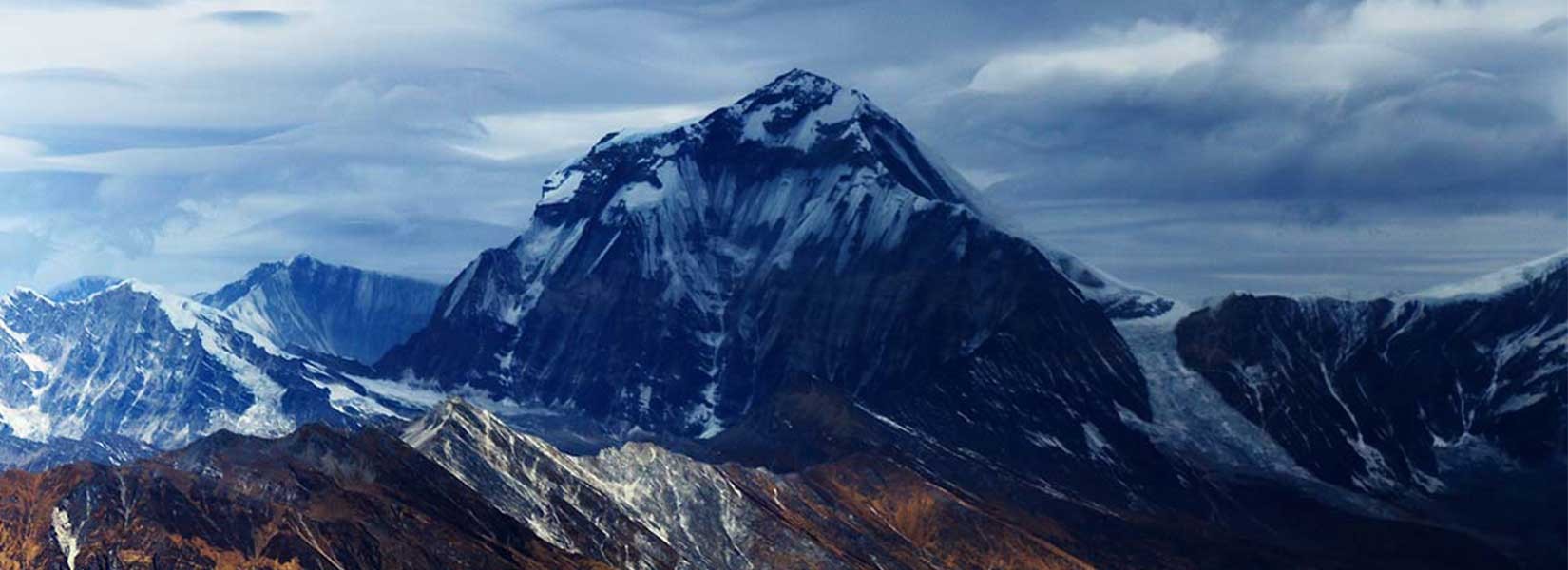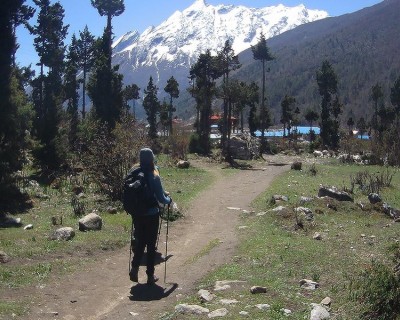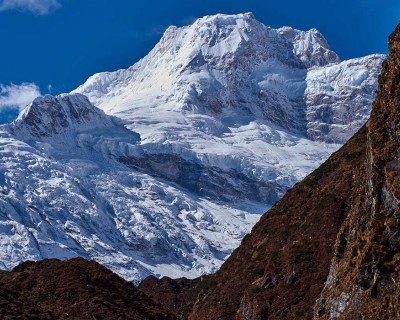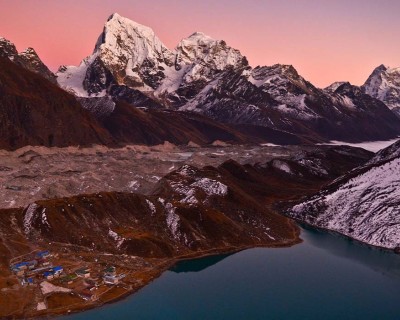There are treks that whisper adventure and then there are trails like Khopra Danda that speak in symphonies. This lesser-known trail in Annapurna region tells the tale of shifting skies, blooming rhododendrons, golden terraced fields and ancient ridgelines. All of which unfurl beneath snow-capped sentinels. Spared from footfall of crowds, Khopra Danda Trek offers something rare, a solitude experience with grandeur. But, to experience this masterpiece in its full glory, understanding the best time for Khopra Danda Trek is everything.
The magic of this off-beaten trekking trail changes with months. It offers a burst of color in spring, crystal skies in autumn, soulful solitude in winter and lush wildness in monsoon. Here, each phase of the year carves its own signature into the landscape and into heart of those who walk it. Hence, the timing of your journey shapes your sights as well as your feelings.
In this detailed seasonal guide, we take you deep into the best time to trek Khopra Danda, exploring mood and rhythm of the trail. We will also provide insights on what kind of experience each season holds.

Spring (March to May)- The Ultimate Trekking Season
Spring is a season of renewal in the Himalayas. Life awakens with soft warmth, crips air and symphony of blooming forests. For those seeking best time for Khopra Danda Trek, spring is most enchanting time to experience natural beauty of Nepal. Mountains re-emerge from their winter slumber and forests bloom with vivid red, pink and white rhododendrons.
But, what sets spring apart isn’t just its visual richness. It also offers a perfect balance between weather, trail conditions and emotional energy of the landscape. Everything feels fresh during spring. Your every step will be accompanied by bird calls, floral scents and golden sunlight that makes Himalayas glow from within.
Spring is a season where Khopra Danda trail is not just something you walk it is an experience you feel deeply, with all senses alive.
Highlights of Spring Season
- Blooming Rhododendron Forest: Landscape changes considerably as you trek across Dobato, Bayeli and Chistibung. The vivid galleries of diverse flora colors are clearly visible. Rhododendrons bloom fiercely across the terrain. Pink shades closer to villages, deep scarlets in mid-hills and soft whites at higher elevations. These gorgeous flowers give color and meaning to the spring season and guide you on with joyous footsteps.
- Stunning Mountain Clarity: During spring, the sky is high and cloudless. The vistas of Annapurna and Dhaulagiri ranges stand out with pristine definition. From the summit of Khopra Ridge itself, the views are world-class. On clear mornings, light bounces across Annapurna, Nilgiri, Machhapuchhre and Dhaulagiri. This creates an unforgettable visual drama.
- Mild Trekker Friendly Temperatures: This nature’s season offers a sweet spot with temperatures. You can hike in light layers during the day without battling heat or extreme cold. At the lower region, the temperatures sits comfortably between 10°C to 20°C. Meanwhile, the upper sections remain chilly enough to feel alpine. But, they are not dangerously cold like winter.
- Bursts of Wildlife and Birds: Other than the colorful scenery, spring is the season of sound and movement. The forest along the route echoes with the flutter of wings and cheerful bird calls. This is the best time to spot exotic species of birds and animals during the trek.
- Joyful Village Atmosphere: Spring in Nepal coincides with several beautiful festivals. Holi, Bisket Jatra and Chaitra Dashain are some captivating celebrations that take place in this season. Walking through traditional villages celebrating the festival will feel like a journey through a breathing culture.
Things to Note: What to Expect During Spring Trek?
- Increased Trail Activity (But Still Tranquil): Although spring attracts more trekkers to Nepal in overall, Khopra Danda remains a less-known gem. During your trek, you will encounter friendly fellow trekkers. But the trail will never feel overrun. Compared to other busier trails nearby like Annapunra Base Camp Trek and Ghorepani Poon Hill Trek, Khopra maintain calm and introspective energy.
- Warm Days, Chilly Nights: The temperature difference between day and night is noticeable. You will be shedding layers by noon in the lower region. But you will bundle up additional layers in evenings and mornings. Prepare for variation in lower and higher altitudes (also between morning and night temperatures) to stay cozy throughout the trek.
- Late May Shower and Humidity: By end of May, there is a subtle change in weather patterns. As monsoon reaches doorsteps, late May can introduce you to occasional afternoon showers. These light rainfalls are not disruptive. However, they can make the trail slightly slippery and reduce mountain visibility. Thus, early spring (March to mid-May) remains gold standard period. This phase has dry and stable weather conditions.
- Teahouses Fully Open and Welcoming: During this best time for Khopra Ridge Trek, trail comes alive with full hospitality. Teahouses along the trail are well-stocked, kitchens are busy and lodges have extra blankets. You will also be able to enjoy warm showers (in some areas). Locally grown, healthy and delicious veggies are also back on the menu.
- Perfect Conditions for Photography and Stargazing: The dramatic lighting, floral frames and cloud-kissed skies create a perfect environment for photography. Changing landscapes, beautiful culture and warm human encounters make for rich and memorable impressions. Similarly, clear skies mean stars come alive at night. At higher part of the trail, there is minimal light pollution. Thus, you will see constellation like never before.
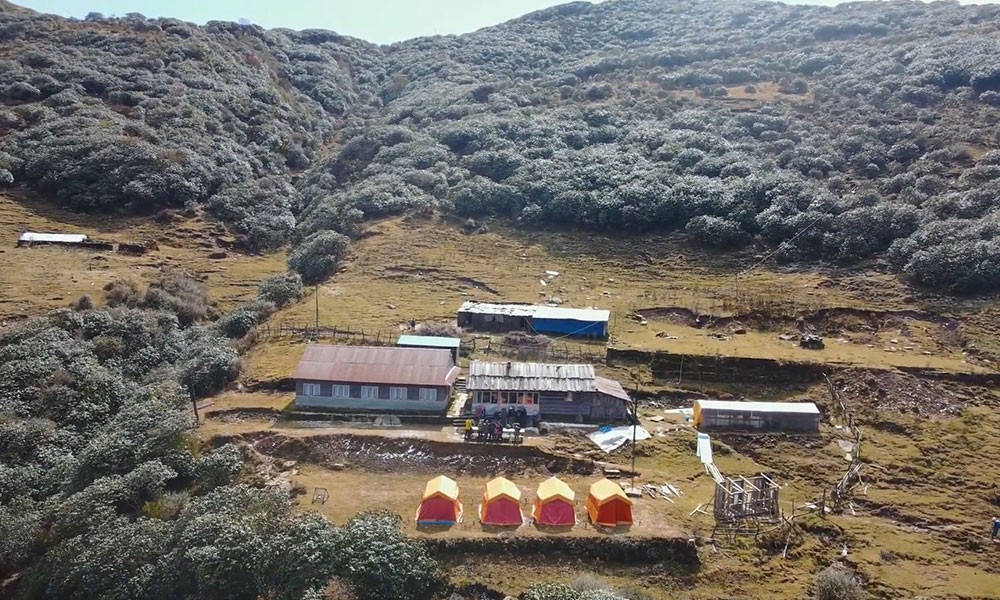
Autumn (September to November)- The Clear Sky Season
Autumn is another best time for Khopra Danda Trek when the mountains reveal themselves. The pristine Himalayas claim their most majestic form in this season. By this point, monsoon has passed and dust has settled. What remains is a landscape that is freshly bathed and incredibly vivid. The colors are deeper, the air is clear and the trails are more defined.
It is no wonder that many seasoned trekkers prefer autumn season. It is an experience like hiking through a living postcard. This fall season is defined by its crystal clarity and crisp vitality. Every ridge line, village and distant peak feels sharper and more present. The river runs full due to monsoon nourishment.
The fields glisten with gold in this harvest season and Himalayan sky stretches like an endless dome. For those who dream of perfect panoramas and immersive mountain silence, autumn season is your ideal companion.
Highlights of Autumn Season
- Exceptional Mountain Clarity: If you are chasing perfect mountain photography during your trek, this is your moment. The entire Dhaulagiri range, Annapurna, Varaha Shikhar and beyond glow magnificently at sunrise. These captivating peaks will also stand stark against deep blue sky during the trek. The Himalayan panorama from Khayer Lake is especially mesmerizing under autumn’s dry and stable atmosphere.
- Comfortable Weather and Trail Conditions: The temperature of Khopra region during autumn ranges from 8°C to 18°C on average. Lower sections generally have comfortable temperatures and it is slightly colder up top. However, hiking conditions are excellent in overall. The trekking trails are firm, dry and welcoming. There are no leeches, snow drift and mid-day heat. Evening can get chilly, especially in November, but it’s just crisp cold and not a harsh one.
- Golden Valleys and Harvest Culture: Connected to rich local life is one of understated joys of trekking in autumn. You will see harvest activities, golden rice fields and post-monsoon festivals. Your journey will take you across traditional Magar and Gurung villages, where this aspect will be a visual and cultural treat. The Himalayan landscape shimmers with shades of gold and bronze. And the hospitality, it feels even warmer.
- Majestic Sunrises and Sunsets: Autumn always comes with very dramatic skies in the country.. In the morning, sun casts a pink hue on snow peaks. Meanwhile, evenings often end in dramatic red and oranges over the ridgelines. The views from Khopra Ridge and other viewpoints are the most magical moments of the trek. There are some really divine moments here when trekkers fall into reverent silence.
- Festivals and Cultural Depth: This best time for Khopra Danda Trek, also happens to be a major festive season in Nepal. You might witness Dashain, the biggest Hindu festival, or Tihar, the festival of light. During this celebratory season, villages are adorned with prayer flags and oil lamps. There is a Tika ceremony, worship of animals and musical events. Thus, the culture feels more open and expressive. This offers trekkers a more meaningful connection beyond the Himalayan landscapes.
Things to Note: What to Expect During Autumn Trek?
- Busy Lodges in Peak Weeks: October is especially popular among international trekkers. Even if Khopra route is less crowded than major trails, teahouses may be fully booked at key stops. It is best to reserve ahead and start trekking early each day to skip the crowds.
- Colder Nights, Especially in Late Autumn: With the advent of November, the temperature at nighttime along the upper reaches of the trails drops considerably At Khopra Ridge, sub-zero temperatures are common after sunset. That’s why proper sleeping bags (rated for -10°C or lower) nd thermal layers are essential for comfort.
- Windy Conditions at Higher Altitudes: Autumn afternoons on exposed ridges can get windy. It is especially so around Khopra Ridge and Khayer Lake. A good windproof jacket and proper headgear are essential to protect against high-altitude wind and chill.
- Shortening Daylight Hours: Late autumn gets chilly and days grow short. Trekkers must start early to ensure reaching the lodges before dark. It is wise to carry a headlamp and plan shorter the daily distances as November approaches.
- Dusty Trails in Lower Sections: Extended dry weather with increasing foot traffic makes some forest trails dusty across the mid-hilly region. Such conditions are noticeable near Ghandruk and Tadapani regions. A lightweight buff or face covering can help especially for sensitive lungs.
Winter (December to February)- For Solitude Seekers
Winter in Himalayas is not just a season but a complete transformation. The usual busy trails go silent, trail empties out and soft white stillness blankets mountains. For solitude seekers, this is the time when Khopra Danda becomes more than a trek. It becomes an unforgettable retreat. The pristine snow decorates pine and rooftops of villages.
Even air feels heavier, quieter and more sacred. With fewer travelers on trekking trail, each step feels intimate. In a winter trek, you will not just be rushing toward a destination. You will be walking through a world that’s paused and frozen in serene beauty.
If you are seeking stillness, reflection, or a relaxed breath away from noise of the world, winter can be your quiet companion.
Highlights of Winter Season
- Peace and Crowd-Free Trails: In the core part of winter, Khopra Danda route becomes a tranquil path. It feels like it is carved for just a handful of adventurers. You can walk for hours without meeting another soul. It allows a full immersion in the natural environment. The silence is meditative. It will be like it’s just you, crunch of snow underfoot and distant call of a winter bird echoing across the valley.
- Pristine Snowfall and Icy Vistas: During winter, snowfall purifies everything. From rhododendron forest to prayer flags on ridges, everything is covered with a layer of snow. If reached without snow blockage, Khopra Ridge is going to offer the most surreal winter panoramas of the Annapurna. Annapurna winter panoramas. In winter, the peaks like Annapurna and Dhaulagiri look razor-sharp and dramatic against the winter sky.
- Cozy Teahouses: There is a special charm about teahouses in winter evenings. Steam rises from mugs of masal tea, conversations are soft and there is warmth and serenity near the fireplace. Blankets, hot meals and shared warmth among local and other travelers create moments of rare simplicity and connection.
- Breathtaking Starry Nights: At this point, the air turns dry and light pollution fades to a minimum. The winter skies are absolutely mesmerizing. Stargazing from your teahouse porch or silent ridge feels like an otherworldly experience. Watching Milky Way cutting across heaven like a frozen river of light in a serene night will feel like universe itself is keeping you company.
- Photography Heaven: If you are into photography, winter season offers an exceptional clarity, contrast and color. The interplay of white snow, dark forests and golden sunbeams creates a picturesque scenery at every turn. Even things as simple as frost on prayer wheels and flags or icicles hanging from rooftops become subject of poetry.
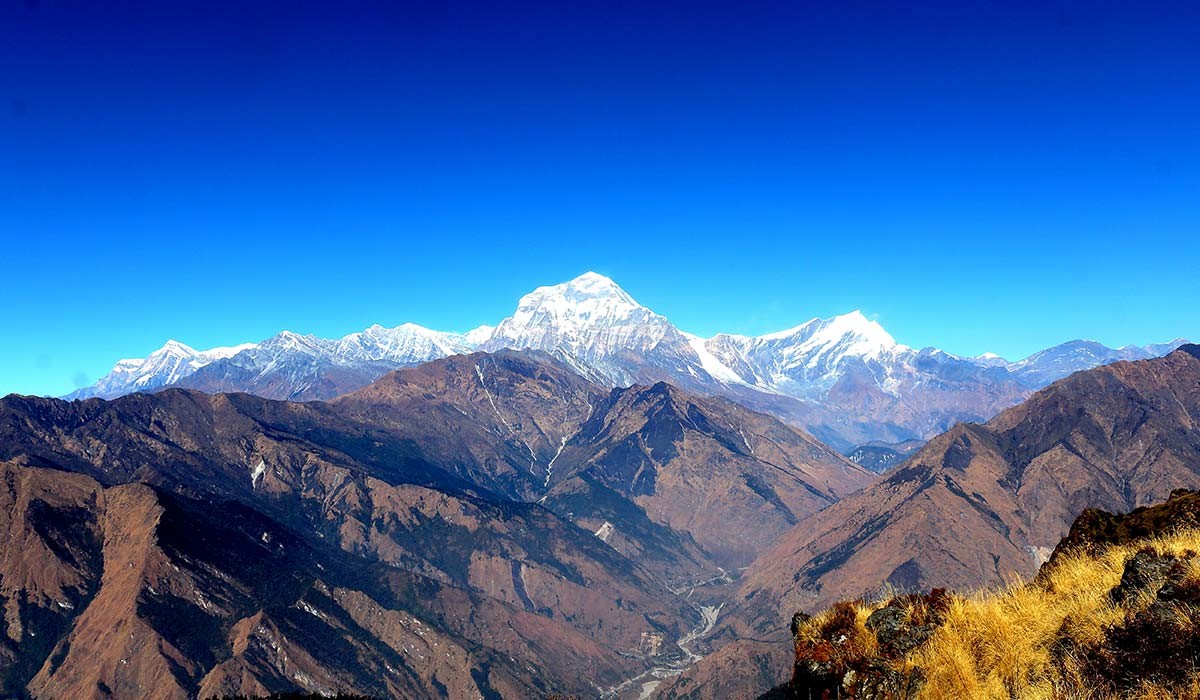
Things to Note: What to Expect During Winter Trek?
- Extreme Cold at Higher Altitudes: Temperatures can fall below -10°C at higher altitudes. So there's no getting away from it-needing proper gear. You need to bring insulated jackets, thermal layers, windproof gloves and a high-quality sleeping bag. Even during the daytime, wind chill can bite hard up on those exposed ridges.
- Snow-Covered and Inaccessible Trails: The upper trails toward Khayer Lake are often snow-covered and impassable. Depending on snowfall levels, even trekking might require caution and technical navigation. It is an absolute necessity to stay updated on trail conditions and hire an expert local guide during a winter trek.
- Limited Teahouse Availability: Some teahouses, especially at higher elevations, may close for the winter season. Or, they only operate with minimal staff. Advance booking and flexible planning are essential to manage accommodation under such conditions. In return, you will receive a rare level of personal attention and quietness at the teahouses that remain open.
- Shorter Daylight Hours: Days in winter are brief and darkness falls fast. Start your trekking early each morning to reach the marked destination before dusk. In any case, having a reliable headlamp and extra batteries is vital. They can be lifesaver especially if unexpected delays occur.
- Transport and Weather Uncertainty: Winter weather can affect road access to trailheads. This can be a hurdle, particularly after snow or frost. Flights and buses may be delayed or canceled. Similarly, the jeep routes could become icy or muddy. Even if lower parts are not affected that much by snow or frost, higher regions can take quite a bit of damage under severe weather. So, always keep buffer days in your itinerary and be open to last-minute changes.
Monsoon/Summer (June to August)- The Offbeat Choice
Unlike other seasons across the year monsoon is especially for wild-hearted. When rain sweeps across Himalayas, lands become alive in a way only a few experience. Hills turn lush, waterfalls spill like silver ribbons across cliffs and wildflowers bloom with riotous colors. Yes, the mountains may hide behind curtains of mist. But, in return, you will get raw and unfiltered intimacy with nature.
Monsoon may not be the season for clear views. But it is certainly for inner journeys, unexpected beauty and joy of trekking a trail only a few dare in rain-soaked silence. If you thrive on adventure and unpredictability. Khopra Danda Trek in monsoon becomes a different story altogether. A lush, quiet and drenched beauty in greenery.
Highlights of Monsoon Season
- Lush Greenery and Forest Magic: This season, breathe life into every leaf and root with rain. Forest at lower trails turns into an emerald sanctuary. Every shade of green seems to exist at this point. The journey is not just beautiful, it’s immersive, like walking through a living jungle of dreams.
- Spectacular Waterfalls and Streams: Everywhere, water is flowing through the hilly landscape of Nepal. Tiny streams swell into gushing waterfalls that spill beside the trail. Water trickles down rock walls, flows beneath footbridges and dances in every direction. The sound of falling and rushing waters serves as background music during your trip.
- Rich Flora and Himalayan Wildflowers: The wildflowers are in full bloom in the Himalayas. Vibrant and diverse flowers sprout from damp rock and meadows. The Himalayan terrain in this phase is a botanist’s dream and absolute delight for anyone with an eye for beauty.
- Deep Local Cultural Connections: There are only few tourists braving through monsoon hurdles. Locals are more relaxed and more open to meaningful conversations. You may be invited for a cup of tea or even into someone’s home. It is a wonderful chance to engage with Gurung and Magar traditions on a personal level.
- Flexible Logistics: Although monsoon may not ideal best time for Khopra Danda Trek, you will be able to enjoy greater flexibility. There are fewer bookings and more availability of facilities along the trail. You will be able to enjoy journey at your own pace and stay longer at beautiful spots without worrying about crowds or reservations.
Things to Note: What to Expect During Monsoon Trek?
- Frequent Rain and Slippery Trails: One of the biggest challenges this season is the weather itself. Rain is frequent, sometimes it is light and sometimes it is torrential. Trail becomes muddy and stones turn slick underfoot. A good pair of trekking poles and high-grip boots are must-haves during a monsoon trek. Waterproof rain is also non-negotiable.
- Obscured Mountain Views: If you are hoping for postcard-perfect Himalayan vistas, monsoon may disappoint you. Cloud often views the peaks and visibility can shift rapidly. However, early morning sometimes surprises you with moments of jaw-dropping clarity before mists roll in.
- Leeches and Bugs in Forest Zone: Wet forest floors become home to leeches during monsoon. While they may be harmless, they can be annoying. Don’t forget to carry salt. Dettol-soaked cotton and wear a leech sock to keep them away. Also, expect a few buzzing insects along the forest's route. Though they lessen at higher elevations.
- Landslides and Trail Blockages: With heavy rainfall comes the risk of landslides on mountain roads and trekking trails. The mid-hill trails, for example, may be affected by landslides. So, always stay updated about the trail conditions and check with local before proceeding. You also need to stay flexible with your itinerary so you can shift your itinerary plan in case of adverse weather.
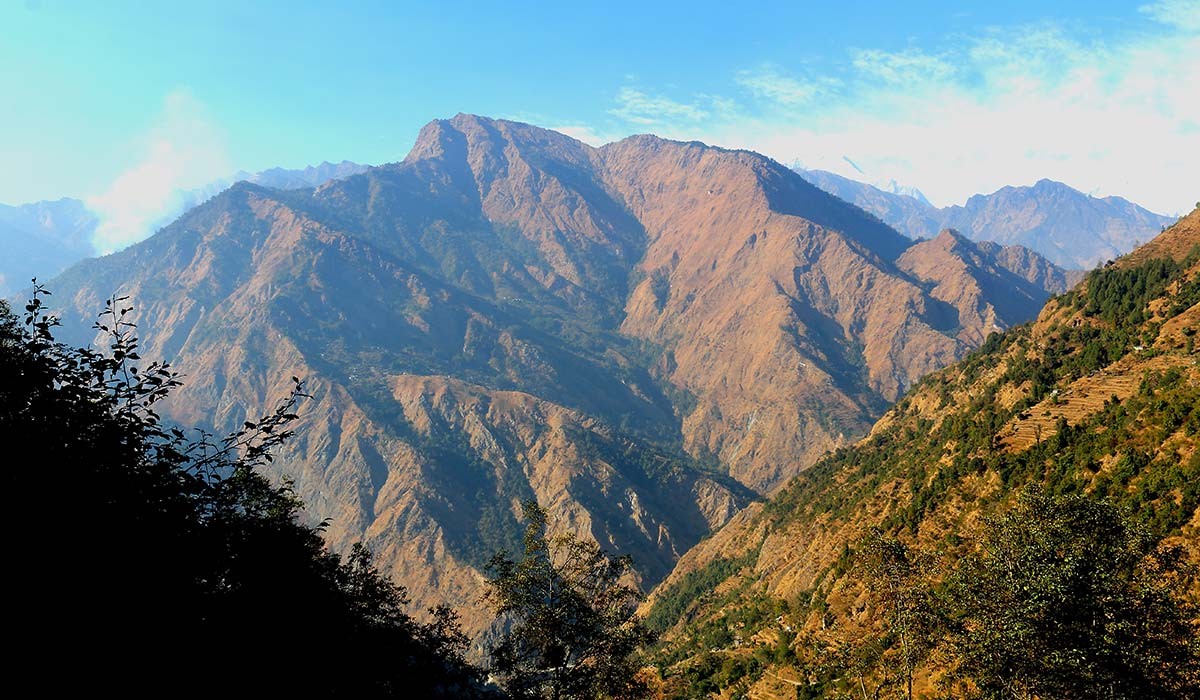
Conclusion: When Should You Go?
Khopra Danda Trek best time is not just about the weather; it is about what you want from your journey. Do you long for sun-drenched trails framed in blooming rhododendrons? Then spring will call to your soul like an alpine symphony. If you are a mountain romantic craving golden hills and postcard panoramas, the fall atmosphere of autumn will be your poetic passage.
In case if you are chasing silence, snowfall and solitude, winter holds a rare magic in its frozen stillness. And, if you are a bold spirit who is drawn to lush jungles, earthy scent and heartbeat of Himalayan rains, monsoon might just be your unexpected muse.
For this relatively easy to mild level of Himalayan trekking trail, no season is less. The only difference is in story and tone. This trekking adventure, in every season, teaches something unique. So, the real question is, what kind of journey are you ready for?
Seasonal Comparison Table: Khopra Danda Trek at a Glance
Season | Best For | Mountain Views | Trail Conditions | Crowd Level | Temperatures |
Spring (March to May) | Blooming forest, clear skies and comfortable temperatures | Excellent | Dry, well-trodden | Moderate (not crowded) | 10°C to 20°C (lower zones) |
Autumn (September to November) | Clear views and cultural immersion | Spectacular | Dry and stable | Slightly busy | 8°C to 18°C (varies by altitude) |
Winter (December to February) | Snow scenery, solitude seekers | Clear but snowbound | Icy and possible snow blockage | Very low (peaceful) | 10°C to -10°C (lower altitude to alpine zones) |
Monsoon (June to August) | Lush greenery, offbeat explorers | Often obscured | Muddy, wet and slippery | Very low (off-season) | 12°C to 25°C (humid and lush) |



